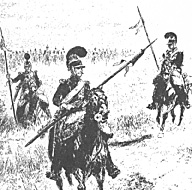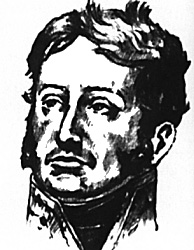
In the mid-1960's, Col. John Elting (author of Swords Around A Throne) prepared some supplementary matter on the battle of Waterloo for classroom instructors at the U. S. Military Academy at West Point, New York. The following is a portion of that material used in conjunction with map plates 160-168 from A Military History and Atlas of the Napoleonic Wars, a book Elting prepared with General Esposito (published in 1964). These excerpts from that instructor's guide summarize Grouchy's pursuit of the defeated Prussians after the battle of Ligny on 16 June, 1815. The perspective looks at how things went awry for the French rather than focus solely on Marshal Grouchy's role, without ignoring his responsibility in Napoleon's defeat at Waterloo.
 The Pursuit of Blucher was marked by the
malign fate that haunted Napoleon's operations
during this campaign. Pajol [I Reserve Cavalry
Corps], the only French commander to show
energy and intelligence, was sent down the
Namur highway. (Imagine the results if Pajol,
instead of Exelmans [II Reserve Cavalry
Corps], had been sent toward Gembloux.)
The Pursuit of Blucher was marked by the
malign fate that haunted Napoleon's operations
during this campaign. Pajol [I Reserve Cavalry
Corps], the only French commander to show
energy and intelligence, was sent down the
Namur highway. (Imagine the results if Pajol,
instead of Exelmans [II Reserve Cavalry
Corps], had been sent toward Gembloux.)
(1) One brigade of Exelmans' corps (dragoons) moved out shortly after Sombreffe was evacuated. Bound for Gembloux, it became lost and followed Pajol down the Namur highway. Shortly thereafter, some Belgians informed its commander that the Prussians had marched for Gembloux. The commander halted, sent a courier to Exelmans, but did not think to warn Pajol.
(2) Exelmans ordered this brigade to Gembloux, and marched promptly with the rest of his corps. He did tell Grouchy that Prussians were reported in Gembloux, but only in very general terms. At Gembloux, he found a force (Thielemann), which he estimated accurately at 20,000, but he did not report this to Grouchy and he did not warn Pajol. (The two of them had 4,400 cavalry, 3,000 infantry and some 24 guns enough to fix Thielemann until reinforcements came up.) His [Exelmans] dragoons behaved so peaceably that Thielemann mistook them for Prussian cavalry!
(3) The cavalry reconnaissance made toward Tilly was commanded by a senior staff officer. It got off late, the French outposts not having noted the Prussian evacuation of Brye, and penetrated to Mont-St. Guibert, where it was halted by Prussian cavalry. What reports it made are unknown; Grouchy complained that Soult [Napoleon's new chief-of-staff] did not pass them to him.
(4) Grouchy always had displayed a certain dread of responsibility. Now, saddled with two strong-charactered subordinates in Vandamme [III Corps] and Gerard [IV Corps], and overwhelmed with detail because of the lack of an adequate staff, he failed to assert himself.
(5) Grouchy's original written orders have disappeared; they were issued to confirm earlier verbal ones. Insofar as they can be reconstructed, Grouchy was to:
(a) Reconnoiter toward Namur and Maastricht, and to pursue the enemy.
(b) Keep Napoleon advised as to the Prussian activities, especially of any movements that would suggest that Blucher and Wellington were attempting to join forces.
(c) Maintain contact with Napoleon through the establishment of a line of courier posts along the Namur-Nevilles highway to Quatre-Bras.
(d) Keep his infantry well concentrated and maintain full freedom of maneuver, should retreat become necessary.
(e) If the Prussians had evacuated Namur, to order the nearest major French garrison (Charlemont) to send a unit of National Guards to occupy that city. (Either Grouchy forgot this instruction, or the commander at Charlemont was slow to obey.)
(6) Grouchy's worst immediate failure was that of not establishing the courier chain to ensure his communications with Napoleon. This was a routine duty, in which he had plenty of experience, but-in previous campaigns-the establishment of these communications normally had been Berthier's responsibility [Napoleon's former chief-of staff who died before the Waterloo campaign. Soult apparently never thought of it. Grouchy remembered it only late on the night of 17-18 June.
(7) Grouchy did not have enough men to "complete Blucher's defeat" (as his mission is sometimes stated), but he was strong enough either to deal with a Prussian flank or rear guard, or to fight a major delaying action.
Col. Elting added the following notes to our questions about Grouchy's pursuit for this article:
What held the pursuit up on 17 June was a bad case of the "fog of war": Ney hadn't reported; the Prussian army had been so fragmented that the line of retreat followed by its formed units was hard to determine. (To make matters worse, the most aggressive reconnaissance-Pajol's-went down the Namur road and originally made fairly large captures.) His original route, to Gembloux, would enable him to scout all the probable Prussian lines of withdrawal.
None of the routes open to Grouchy [to move to Napoleon's aid] were very good- vague memory of one being described as a "trough of mud." However, the French could have marched at least as fast as the Prussians. An advance into the flank of Blucher's strung-out army probably could have halted Blucher and freed Lobau for a stroke at Wellington's left flank.
Grouchy didn't have to reach Waterloo and actually join Napoleon-he merely had to come in on Blucher's flank. In that sense, Grouchy is responsible. Poor staff work by Soult contributed. But of course we'll never be sure because so many probable orders have vanished without trace, having only rumors-which may in many cases have been "inspired."
With special thanks to Quantum Press for the use of Detaille's pictures from their fine book, L'Armee Francaise.
 [General Pajol: "the only French commander to show energy and intelligence..."]
[General Pajol: "the only French commander to show energy and intelligence..."]
Back to Table of Contents -- Napoleon #1
Copyright 1995 by Emperor's Press.